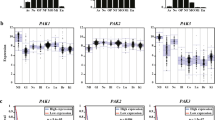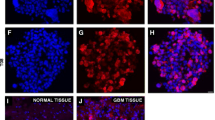Abstract
Purpose: Glioblastomas (GBMs) are the most common primary malignant brain tumors. Majority of GBMs has loss of heterozygosity of chromosome 10. The PAX6 encodes a transcription factor that involves in development of the brain, where its expression persists. We have reported that the expression of PAX6 was significantly reduced in GBMs and that a low level of PAX6 expression is a harbinger of an unfavorable prognosis for patients with malignant astrocytic glioma. Interestingly, PAX6 expression was increased in suppressed somatic cell hybrids derived from introducing a normal human chromosome 10 into U251 GBM cells. Thus it is interesting to determine if repression of PAX6 expression is involved in anti-tumor suppression function in GBM.
Experimental design: We overexpressed PAX6 in a GBM cell line U251HF via either stable transfection or infection with recombinant adenovirus, and examined cell growth in vitro and in vivo.
Result: Although we did not observe changes in the cell doubling time for PAX6-stable transfectants, significantly fewer numbers of PAX6-positive colonies grew in soft agar. Transient overexpression of PAX6 via adenovirus, however, suppressed cell growth by increasing the number of cells in G1 and by decreasing the number of cells in S-phase, and later on caused a dramatic level of cell death. Repeated subcutaneous and intracranial implantation experiments in nude mice using PAX6-stable transfectants provided solid evidence that PAX6 suppressed tumor growth in vivo and significantly extended mouse survival.
Conclusion: Our data demonstrate that PAX6exerts a tumor suppressor function that limits the growth of GBM cells.
Similar content being viewed by others
Abbreviations
- AA:
-
anaplastic astrocytoma
- GBM:
-
glioblastoma multiforme
- P.I:
-
propidium iodide
- QRT-PCR:
-
quantitative reverse transcriptase-polymerase chain reaction
References
BK Rasheed RN Wiltshire SH Bigner et al. (1999) ArticleTitleMolecular pathogenesis of malignant gliomas Curr Opin Oncol 11 162–167
CBTRUS: Statistical Report: Primary Brain Tumors in the United States, 1992–1997. The Central Brain Tumor Registry of the United States, Chicago, 2000
BK Rasheed GN Fuller AH Friedman et al. (1992) ArticleTitleLoss of heterozygosity for 10q loci in human gliomas Genes Chromosomes Canc 5 75–82
A Deimling Particlevon K Ammon Particlevon D Schoenfeld et al. (1993) ArticleTitleSubsets of glioblastoma multiforme defined by molecular genetic analysis Brain Pathol 3 19–26 Occurrence Handle8269081
DT Ransom SR Ritland CA Moertel et al. (1992) ArticleTitleCorrelation of cytogenetic analysis and loss of heterozygosity studies in human diffuse astrocytomas and mixed oligo-astrocytomas Genes Chromosomes Cancer 5 357–374
H Kon Y Sonoda T Kumabe et al. (1998) ArticleTitleStructural and functional evidence for the presence of tumor suppressor genes on the short arm of chromosome 10 in human gliomas Oncogene 16 257–263
RN Wiltshire BK Rasheed HS Friedman et al. (2000) ArticleTitleComparative genetic patterns of glioblastoma multiforme: potential diagnostic tool for tumor classification Neuro-oncology 2 164–173
W Liu CD James L Frederick et al. (1997) ArticleTitlePTEN/MMAC1 mutations and EGFR amplification in glioblastomas Cancer Res 57 5254–5257
DN Louis (1997) ArticleTitleA molecular genetic model of astrocytoma histopathology Brain Pathol 7 755–764 Occurrence Handle1:CAS:528:DyaK2sXjtVKhu7s%3D Occurrence Handle9161727
M Nozaki M Tada H Kobayashi et al. (1999) ArticleTitleRoles of the functional loss of p53 and other genes in astrocytoma tumorigenesis and progression Neuro-oncology 1 124–137
TI Simpson DJ Price (2002) ArticleTitlePax6; a pleiotropic player in development Bioessays 24 1041–1051
Ton CC H Hirvonen H Miwa et al. (1991) ArticleTitlePositional cloning and characterization of a paired box- and homeobox-containing gene from the aniridia region Cell 67 1059–1074 Occurrence Handle10.1016/0092-8674(91)90284-6 Occurrence Handle1:CAS:528:DyaK3sXhs1Kmsbw%3D Occurrence Handle1684738
J Prosser V Heyningen Particlevan (1998) ArticleTitlePAX6 mutations reviewed Hum Mutat 11 93–108
SM Sisodiya SL Free KA Williamson et al. (2001) ArticleTitlePAX6 haploinsufficiency causes cerebral malformation and olfactory dysfunction in humans Nat Genet 28 214–216
A Stoykova P Gruss (1994) ArticleTitleRoles of Pax-genes in developing and adult brain as suggested by expression patterns J Neurosci 14 1395–1412
M Gotz A Stoykova P Gruss (1998) ArticleTitlePax6 controls radial glia differentiation in the cerebral cortex Neuron 21 1031–1044
T Sun NP Pringle AP Hardy et al. (1998) ArticleTitlePax6 influences the time and site of origin of glial precursors in the ventral neural tube Mol Cell Neurosci 12 228–239
A Mansouri M Hallonet P Gruss (1996) ArticleTitlePax genes and their roles in cell differentiation and development Curr Opin Cell Biol 8 851–857
M Sander A Neubuser J Kalamaras et al. (1997) ArticleTitleGenetic analysis reveals that PAX6 is required for normal transcription of pancreatic hormone genes and islet development Genes Dev 11 1662–1673
YH Zhou F Tan KR Hess et al. (2003) ArticleTitleThe expression of PAX6, PTEN, vascular endothelial growth factor, and epidermal growth factor receptor in gliomas: relationship to tumor grade and survival Clin Cancer Res 9 3369–3375
IP Gorlov GF Saunders (2002) ArticleTitleA method for isolating alternatively spliced isoforms: isolation of murine Pax6 isoforms Anal Biochem 308 401–404
JA Epstein T Glaser J Cai et al. (1994) ArticleTitleTwo independent and interactive DNA-binding subdomains of the Pax6 paired domain are regulated by alternative splicing Genes Dev 8 2022–2034
Z Kozmik T Czerny M Busslinger (1997) ArticleTitleAlternatively spliced insertions in the paired domain restrict the DNA sequence specificity of Pax6 and Pax8 EMBO J 16 6793–6803
MA Pershouse E Stubblefield A Hadi et al. (1993) ArticleTitleAnalysis of the functional role of chromosome 10 loss in human glioblastomas Cancer Res 53 5043–5050
PA Steck AH Ligon P Cheong et al. (1995) ArticleTitleTwo tumor suppressive loci on chromosome 10 involved in human glioblastomas Genes Chromosomes Cancer 12 255–261
LD Ke YX Shi SA Im et al. (2000) ArticleTitleThe relevance of cell proliferation, vascular endothelial growth factor, and basic fibroblast growth factor production to angiogenesis and tumorigenicity in human glioma cell lines Clin Cancer Res 6 2562–2572
Y Zhou JB Zheng X Gu et al. (2000) ArticleTitleA novel Pax-6 binding site in rodent B1 repetitive elements: coevolution between developmental regulation and repeated elements Gene 245 319–328
HK Tang LY Chao GF Saunders (1997) ArticleTitleFunctional analysis of paired box missense mutations in the PAX6 gene Hum Mol Genet 6 381–386
S Lal M Lacroix P Tofilon et al. (2000) ArticleTitleAn implantable guide-screw system for brain tumor studies in small animals J Neurosurg 92 326–333
HK Tang S Singh GF Saunders (1998) ArticleTitleDissection of the transactivation function of the transcription factor encoded by the eye developmental gene PAX6 J Biol Chem 273 7210–7221
N Heins P Malatesta F Cecconi et al. (2002) ArticleTitleGlial cells generate neurons: the role of the transcription factor Pax6 Nat Neurosci 5 308–315
G Estivill-Torrus H Pearson V Heyningen ParticleVan et al. (2002) ArticleTitlePax6 is required to regulate the cell cycle and the rate of progression from symmetrical to asymmetrical division in mammalian cortical progenitors Development 129 455–466
PA Steck H Lin LA Langford et al. (1999) ArticleTitleFunctional and molecular analyses of 10q deletions in human gliomas Genes Chromosomes Cancer 24 135–143
M Fujimoto DW Fults GA Thomas et al. (1989) ArticleTitleLoss of heterozygosity on chromosome 10 in human glioblastoma multiforme Genomics 4 210–214 Occurrence Handle1:STN:280:BiaB1M%2FosFQ%3D Occurrence Handle2544511
AE Karlbom CD James J Boethius et al. (1993) ArticleTitleLoss of heterozygosity in malignant gliomas involves at least three distinct regions on chromosome 10 Hum Genet 92 169–174
R Albarosa BM Colombo L Roz et al. (1996) ArticleTitleDeletion mapping of gliomas suggest the presence of two small regions for candidate tumor-suppressor genes in a 17-cM interval on chromosome 10q Am J Hum Genet 58 1260–1267
K Ichimura EE Schmidt A Miyakawa et al. (1998) ArticleTitleDistinct patterns of deletion on 10p and 10q suggest involvement of multiple tumor suppressor genes in the development of astrocytic gliomas of different malignancy grades Genes Chromosomes Cancer 22 9–15
PA Steck MA Pershouse SA Jasser et al. (1997) ArticleTitleIdentification of a candidate tumour suppressor gene, MMAC1, at chromosome 10q23.3 that is mutated in multiple advanced cancers Nat Genet 15 356–362 Occurrence Handle10.1038/ng0497-356 Occurrence Handle1:CAS:528:DyaK2sXitF2hs70%3D Occurrence Handle9090379
DM Li H Sun (1998) ArticleTitlePTEN/MMAC1/TEP1 suppresses the tumorigenicity and induces G1 cell cycle arrest in human glioblastoma cells Proc Natl Acad Sci USA 95 15406–15411
J Li C Yen D Liaw et al. (1997) ArticleTitlePTEN, a putative protein tyrosine phosphatase gene mutated in human brain, breast, and prostate cancer Science 275 1943–1947
N Ishii D Maier A Merlo et al. (1999) ArticleTitleFrequent co-alterations of TP53, p16/CDKN2A, p14ARF, PTEN tumor suppressor genes in human glioma cell lines Brain Pathol 9 469–479
Author information
Authors and Affiliations
Corresponding author
Rights and permissions
About this article
Cite this article
Zhou, YH., Wu, X., Tan, F. et al. PAX6 suppresses growth of human glioblastoma cells. J Neurooncol 71, 223–229 (2005). https://doi.org/10.1007/s11060-004-1720-4
Accepted:
Issue Date:
DOI: https://doi.org/10.1007/s11060-004-1720-4




